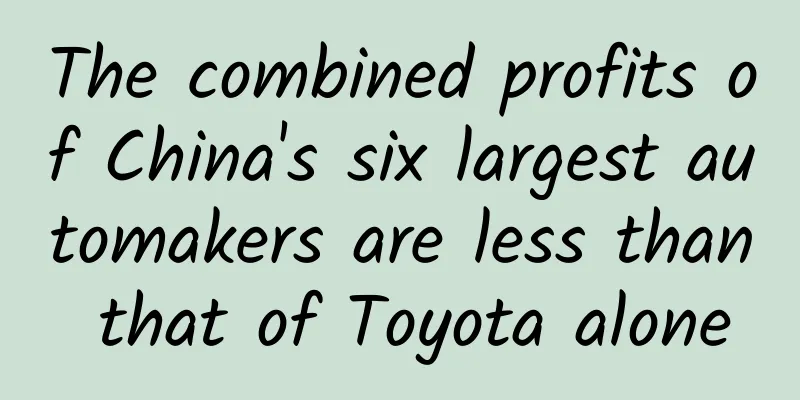The combined profits of China's six largest automakers are less than that of Toyota alone

|
The latest Fortune Global 500 list was released, and there are 6 Chinese automakers on the list this year, which is the same as the number of Japanese companies. However, high operating income does not mean high profits for automakers: in the first half of 2017, the total profit of the six automakers, SAIC, Dongfeng, FAW, BAIC, GAC and Geely, was US$11.7227 billion, less than the total profit of Toyota Motor (TM) of US$16.8993 billion. Domestic brands account for more than 40% of sales in China's auto market, but profits are not optimistic. The latest Fortune Global 500 list has always been the most famous and authoritative list for measuring large global companies. This year, a total of 6 Chinese automakers made the list, the same as last year, and the same number as Japanese companies. Among them, SAIC rose 5 places to 41st, Dongfeng rose 13 places to 68th, FAW rose 5 places to 125th, BAIC rose 23 places to 137th, GAC rose 65 places to 238th, and Geely, a star automaker of private independent brands in the past two years, rose 67 places to 343rd. The latest statistics from the China Association of Automobile Manufacturers show that in the first half of 2017, the market share of Chinese self-owned brand cars was 43.9%, an increase compared to the same period in 2016. Previously, the market share of Chinese self-owned brand passenger cars had risen rapidly from 38.31% in 2014 to 43.24% in 2016. There are also hidden worries under the gratifying situation. High operating income does not mean high profits for car companies. In the passenger car market, there are actually only three companies that truly rely on their own brands to obtain large-scale profits: Great Wall, Geely and BYD. In 2016, the three companies had a combined net profit of about 20.7 billion yuan, roughly equivalent to 80% of Volkswagen's profits in China. According to statistics from the first half of 2017, the total profit of the six automakers, SAIC, Dongfeng, FAW, BAIC, GAC and Geely, was US$11.7227 billion, less than the total profit of Toyota Motor (TM) of US$16.8993 billion. There is a big gap between Chinese automakers and overseas automakers. "Everyone wants to focus on profits, but the increase in profits is constrained by many factors." Yin Chengliang, deputy director of the Automotive Engineering Research Institute of Shanghai Jiaotong University, who has been tracking the development of China's independent automobile brands for a long time, told the First Financial reporter that there are many reasons why independent brands have small profits but quick turnover. The first is the brand value of the car, which cannot be reversed overnight. The brand reputation and value of international auto giants require years of accumulation by latecomers. In terms of profit per vehicle, China's leading independent brand car company Great Wall Motor (601633.SH) achieved a net profit of 10.547 billion yuan in 2016, a year-on-year increase of 30.87%. Great Wall Motor's cumulative sales in 2016 were 1.0745 million vehicles, a year-on-year increase of 26.01%, which is equivalent to a profit of about 10,000 yuan per vehicle. GAC Group (601238.SH)'s own car company GAC Passenger Car had an operating income of 32.808 billion yuan and a net profit of 3.043 billion yuan in 2016. This means that GAC Passenger Car contributed nearly half of GAC Group's 6.288 billion yuan in net profit. The profit per car is about 8,000 yuan. Toyota Motor's profit in fiscal year 2016 was approximately 1.7 trillion yen (approximately 15.1 billion U.S. dollars). Toyota Motor's cumulative global sales in 2016 (including Daihatsu and Hino under the group) were 10.175 million vehicles. Toyota Motor Group's profit per vehicle was approximately 1,500 U.S. dollars, but the sales volume of models that maintain this profit far exceeds that of Chinese independent brands. Porsche, which has a higher profit per vehicle, delivered 237,778 new vehicles in 2016, up 6% year-on-year, and achieved revenue of 22.3 billion euros, up 4% year-on-year. At the same time, sales profit increased by 14% to 3.9 billion euros. In this way, Porsche's profit per vehicle reached 15,600 euros, or 116,000 yuan in total, which is more than ten times that of Chinese independent brands. Not only are profits low, but the best-selling models of China's own brands are mostly concentrated in the 100,000 yuan range, and the sales volume decreases more significantly as the price goes up. A reporter from the First Financial Daily found that based on sales statistics of models priced between 120,000 and 150,000 yuan, the sales of the main models of this level of Chinese independent brands in the first half of 2017 were: Changan CS75 sold 106,084 units, Haval H6 sold 226,567 units in the first half of 2017, Geely Borui sold 20,011 units, Geely Boyue sold 124,432 units, and GAC Trumpchi GS4 sold 180,753 units. According to the sales statistics of models priced between 150,000 and 200,000 yuan, the sales of the main models of this level of Chinese independent brands in the first half of 2017 were: Changan CS95 for 15,060 units, Haval H7 for 23,418 units, Haval H8 for 3,797 units, Haval H9 for 5,176 units, and GAC Trumpchi GS8 for 50,622 units. "It is a fact that domestic brands' sedans sell for around 100,000 yuan, and SUVs sell for around 150,000 yuan." Yin Chengliang believes that the 150,000 to 200,000 yuan range is almost the price ceiling for domestic brands at present. This is closely related to the rapid development of China's automobile industry. In order to suppress old rivals and resist new brands, domestic brands have to rely on brand premium to increase sales. They cannot have high profits per vehicle like joint venture brands. In order to enhance their attractiveness, Chinese independent brand car companies are also developing new technologies to increase added value. "In terms of traditional automobiles, research and development has always been the shortcoming of China's independent brands, because most of the original new technologies are reflected in new functions mainly in automotive electronics." Yin Chengliang said that the key is that Chinese car companies must have technical background and control over core technologies. These are the real "roots", and the others are "symptoms". We cannot treat the symptoms without addressing the root cause. The ongoing new energy vehicle revolution may allow domestic brands to overtake others. As the formal implementation of the "Measures for the Parallel Management of Passenger Car Enterprises' Average Fuel Consumption and New Energy Vehicle Credits (Draft for Comments)" is getting closer, according to the "double credits" method, the new energy vehicle credits ratio requirements for passenger car companies in 2018-2020 are 8%, 10%, and 12% respectively. If the credits are not up to standard and the negative credits are not compensated, the car companies will face the penalty of suspension of the application of the car catalog and suspension of the production or import of some traditional car models. This also means that the development model of China's new energy vehicle industry will change from relying on national and local subsidy policies to being forced by the double-point policy to change the development model of new energy vehicles by car companies. Chinese automakers that have done relatively well in their own brands, such as Changan, JAC, BAIC, SAIC, Chery, Geely, and BYD, all have new energy vehicles as their flagship products. Yin Chengliang believes that "it is difficult for these Chinese automakers to compete with international auto giants in traditional fuel vehicles, but in terms of new technologies such as new energy vehicles and intelligent networking, Chinese automakers are not far behind." "New technologies such as new energy and autonomous driving are constantly subverting the traditional automotive industry, and new business models and new industrial ecosystems are constantly being refreshed. In this competition, the strong prey on the weak, and the fast fish eat the slow fish. Not only will you retreat if you don't advance, but even a little progress will also be a retreat." Xu Liuping, chairman of China First Automobile Group Corporation, said that perhaps within five years, many automobile companies, whether joint ventures or independent, will die. As a winner of Toutiao's Qingyun Plan and Baijiahao's Bai+ Plan, the 2019 Baidu Digital Author of the Year, the Baijiahao's Most Popular Author in the Technology Field, the 2019 Sogou Technology and Culture Author, and the 2021 Baijiahao Quarterly Influential Creator, he has won many awards, including the 2013 Sohu Best Industry Media Person, the 2015 China New Media Entrepreneurship Competition Beijing Third Place, the 2015 Guangmang Experience Award, the 2015 China New Media Entrepreneurship Competition Finals Third Place, and the 2018 Baidu Dynamic Annual Powerful Celebrity. |
<<: Tencent's $350 million investment in Kuaishou is the beginning of the post-BAT era
Recommend
Apple's "calling in the rain" ad sparks controversy, but is still a good one
Apple 12’s waterproof advertisement has become po...
Tik Tok new media’s replicable content methodology!
On Tik Tok, only entertainment is the popular con...
2K screen HTC One M9 concept image exposed with extremely narrow bezel
Although it is rumored that HTC's next-genera...
Have you ever thought about running Linux on iOS?
Have you ever thought about running Linux on an i...
Why do allergies always occur in spring?
Spring is supposed to be a beautiful season full ...
Exclusive ranking of “Werewolf Killing” App: Can “killing each other through the air” become the next Kuaishou?
"I still don't understand what Werewolf ...
Why do Samsung Tizen phones always get delayed?
Samsung announced last Friday that the Tizen smart...
Peach gum = cheap bird's nest? Is it really that magical?
In the spring, peach blossoms bloomed quietly, pe...
Have you ever wondered why the whole is greater than the sum of its parts?
Yang Mingzhe If there is a cake like this on the ...
The aerospace industry has come up with a "recycling" strategy: How does "Practice 19" open a new era of reusable satellites?
Author: Duan Yuechu, Huang Xianghong, Huang Yanho...
Hand wash or machine wash? What clothes can't be thrown into the washing machine?
I don’t know if you have ever had this experience...
my country's annual sales of air purifiers reach 5 million units, but 30% of them are substandard
When the haze season comes every year, air purifi...
HTML5 game performance is greatly improved, Egret Engine 1.5 is released
Recently, Egret Times released the latest generat...
An information flow optimizer who consumes more than 2 million per month will teach you how to do advertising scientifically!
With the vigorous development of mobile communica...









